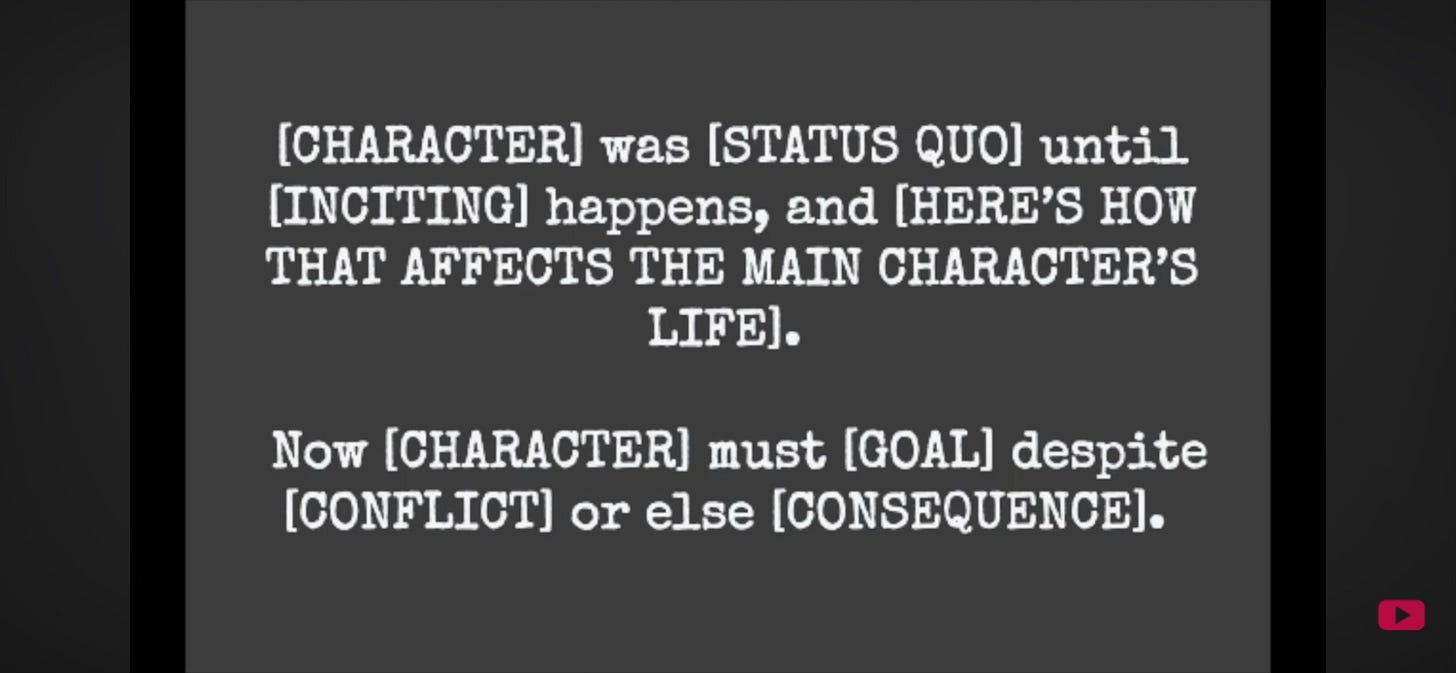How to write a book pitch that grabs agents’ attention
Four proven methods — and the one I use — to distil your novel into two unforgettable sentences
Hi there!
This story begins, as many of the best stories do, in a bar. I was at a book event. A renowned editor from one of the Big Five publishing houses had given a talk, and now she was buying a drink. I decided to take a risk. I ordered a glass of wine, praised her speech, and asked her if I could pitch my book to her. To my surprise, she agreed.
I’m guessing you’ve heard of the elevator pitch? It’s a two-sentence summary of your novel that’s meant to grab the attention of a reader, agent, publisher and make them want to read your book.
Yup. Two sentences.
As
of says, ‘It is very, very, very, very hard to distil a complicated plot into a few sentences.’I’d add it’s particularly hard for a writer to do it. You might have lived with this book for years, inhabited the characters’ minds, imagined their world in detail, and it is complex, nuanced, quirky. And your work-in-progress is probably 80,000 words long.
Two sentences?!
I’ve had to do this exercise with my agent, in front of publishers, to friends, and family (although the latter are more forgiving generally and let you waffle on a bit). I’ve had 12 books published, so I’ve had a bit of practice. So I don’t think I’m good at it, but I’m not bad. Or at least, that’s what I thought.
I took a breath and began. I told the editor about the crime fiction book I was working on (now finished and out on submission).
After I’d spoken for exactly two and a half sentences, she held up her hand and said, ‘Stop! Too long. Go again.’
I think my mouth fell open at that point. I took a sip of my wine, and started over.
‘Stop,’ she shouted when I’d barely begun. ‘Try again.’
The third time round I managed to summarise my novel in three sentences and she let me finish.
She put her head on one side and told me I really needed to work on my elevator pitch skills. She said nice things about my book, but that it wasn’t a genre she was interested in, and wished me well.
I left my unfinished wine on the bar and went home, feeling humbled and humiliated.
Like many of you, I’m now submitting to agents. So I’ve also had to find an agent, write a query letter, and write a pitch for not one, but three finished books.
So here are my thoughts on what works, and what specifically works for me.
I’m going to show you three techniques that industry insiders use, and then a fourth way of thinking about the elevator pitch.
This final one is, in my opinion, a little easier and can produce a more authentic pitch in your own voice. It’s also the one that I teach, including to PhD students to help them summarise the myriad complexities of their thesis.
I’ve also created a handy table summarising everything for you. 💚
And if you missed the previous two, here they are:
1. Simplicity is key
I love the simplicity of this one.
‘If you’re trying to work up an elevator pitch for your book remember, you don’t have to put it all in there. What is the absolute most interesting thing about your book? What is the central conflict? What does your main character want above all else?’
~
It’s by
who is a bestselling author, teaches writing at Northwestern University and writes the Substack,This is her formula:
The (protagonist) wants__and does__to get it and (fails or succeeds).
Fill in the blanks.
Here’s an example with The Hunger Games by Suzanne Collins:
The protagonist: Katniss Everdeen
Wants: to protect her sister and survive the Hunger Games
And does: volunteers to take her sister’s place in the deadly televised tournament, using her hunting skills and alliances to stay alive
And (fails or succeeds): she succeeds in surviving, but changes the rules of the Games and sparks a rebellion.
So the full pitch is:
Katniss Everdeen wants to protect her sister and survive the Hunger Games, so she volunteers to take her place in the tournament, using her skills and alliances to stay alive, and she succeeds — sparking a rebellion that will change her world forever.
2. The four-step approach
This one is by agent
of in her article on how to write a query letter.She says you need four things to write a good book pitch:
1. Something to Root for
2. Change
3. Something Unexpected
4. Vulnerability
Here’s how that plays out:
Something to Root for
Essentially you want the reader to want something to happen to the characters. It could be the character’s goal, or it might be something that might happen to the character that they do not intend or aren’t looking for (for instance, they need to be in a relationship with the wonderful woman next door, but they don’t realise it; we, the reader, do).
Change
But then…something has to happen in your story.
‘Something, or preferably someone, needs to change,’ as Kate says.
Something Unexpected
Then you need a twist. ‘You need something in your book that makes the reader go oh,’ Kate explains.
Vulnerability
It’s the why of your book. Why does the character want what they want, need what they hadn’t realised they wanted? We have to care. No matter the subject of your book, whether’s it’s about octopi or unicorns and plumbers in space, we’ll read it if we care.
As agent Nelle Andrew of Rachel Mills Literary told
, , the number one reason why she will turn a book down is if she doesn’t care.‘If I don’t care what happens to these people and I can live happily without finding out. This is true of all forms for me – whether it is a submission or a published novel or a movie or TV show. If I don’t care, there’s no point.’
Here’s how it might look for Gone Girl by Gillian Flynn:
Something to root for: Nick Dunne just wants his marriage to work and to keep his life together.
Change: But on their fifth wedding anniversary, his wife Amy disappears and suspicion falls squarely on him.
Something unexpected: The story takes a shocking turn when it’s revealed Amy has staged her disappearance to frame Nick for murder.
Vulnerability: Nick must navigate public hatred, police scrutiny and his own failings as a husband to prove his innocence and survive Amy’s manipulation.
So the pitch would be:
Nick Dunne just wants his marriage to work and to keep his life together, but when his wife Amy disappears on their fifth anniversary, suspicion falls on him. The shocking twist: Amy has staged her disappearance to frame Nick for murder. Now, vulnerable to both public hatred and his own flaws, Nick must fight to prove his innocence and survive his wife’s deadly game.
3. The Magic Formula
’s words, not mine! In she gives a formula for you to use.This is gold dust!
[CHARACTER] was [STATUS QUO] until [SOMETHING] happens, and [HERE’S HOW THAT AFFECTS THE MAIN CHARACTER’S LIFE].
Now [CHARACTER] must [GOAL] despite [CONFLICT] or else [CONSEQUENCE].
You can see how this formula encompasses both Sarah Fay and Kate McKean’s approaches and wraps them up into one long sentence.
As Michelle says, if you fill in the blanks, you’ll have a couple of ugly sentences.
But then, the beauty of it is that this will distil the essence of your story and you can then work on making it a lovely, polished piece of prose.
The Girl with the Dragon Tattoo through Michelle Schusterman’s lens:
[CHARACTER] Mikael Blomkvist, an investigative journalist
[STATUS QUO] was disgraced after losing a libel case
[SOMETHING] until he’s hired by wealthy industrialist Henrik Vanger to investigate the decades-old disappearance of his niece
[AFFECTS LIFE] and drawn into the dark secrets of the powerful Vanger family.
[GOAL] Now Mikael, with the help of hacker Lisbeth Salander, must uncover the truth
[CONFLICT] despite threats to his life and Lisbeth’s own haunted past
[CONSEQUENCE] or else a serial killer will remain free and his career — and life — may be destroyed.
So the pitch would be:
Mikael Blomkvist, a disgraced journalist, was at his lowest point until he’s hired to investigate the decades-old disappearance of a young woman, and is drawn into the dark secrets of the Vanger family. Now, with hacker Lisbeth Salander, he must uncover the truth despite deadly threats and Lisbeth’s own demons, or else a serial killer will remain free and Mikael may lose his life as well as his reputation.
I think this is genius and I’d urge you to try it.
But you could end up with a pitch that feels a little generic and you may want something a little more literary, unique or quirky.
So what I do is to take Michelle’s Magic Formula and make notes on who the main character is, the status quo, her goal, the conflict, and so on.
Then I use a fourth approach that is a little easier (in my opinion) and will hopefully help me put together a pitch that reads well and is a pithy summary of the book.
It’s no surprise that the approach I’ve adopted is one which is also taught to Hollywood screenwriters to help them pitch their movie in an authentic but compelling way.
It’s also the one that I teach to PhD students to help them not only summarise their entire thesis, but also, each chapter, and any papers they want to write.
Here’s how it works.
4. The ABT Approach
The ABT approach was developed by a marine biologist, Randy Olson1. He ended up turning down tenure at his university and going to Hollywood to write film scripts. He developed this method of summarising complex ideas and turning them into a blueprint for a story.
It’s a very simple template that will enable you to capture the essentials of your story and summarise it clearly and concisely.
Here it is:
— and —, but —, therefore —.
Here’s how it works:
Connect your opening facts about your character and their situation with an AND.
Then add a BUT - a word that implies contradiction, negation, denial, a change of direction, and forces tension and conflict into your narrative. And as we all know, conflict and change are the driving forces in all stories.
Robert McKee says in Story:
‘Nothing moves forward in a story except through conflict.’
You then add a THEREFORE - which signals the consequence, or the effect of the change and the conflict.
So you can see how this approach is really, really simple, but it still encapsulates the essentials - a character and their situation, something happens, change occurs, and we see the consequences.
Dorothy lives on a farm in Kansas with her aunt, her uncle and her dog, Toto. But one day a violent tornado whisks her to a magical and strange land, where she learns that she cannot return home without the help of the Wizard of Oz. Therefore, she sets out, along the Yellow Brick Road, in the company of a Scarecrow, a Tin Man and a Cowardly Lion, to meet the Wizard of Oz so that she can find her way home.
By the way, you don’t need to use and, but or therefore. You can use other words that do the same job.
The ABT approach is a nuts-and-bolts way of capturing the essentials. It still needs to encompass the following:
Who is the story about? (the protagonist)
What do they want or what problem do they face? (the central conflict)
What’s at stake if they fail? (the consequence or hook)
I’d suggest breaking it down like this:
Start with character + situation: Name your protagonist (or define them clearly if you’re keeping names out) and place them in the most gripping aspect of their life or problem. The AND part of the equation.
Add conflict: Make it clear what they’re up against. Is it a killer, a family secret, a mystery, an internal struggle? The BUT part of the formula.
Raise the stakes: Why should we care? Life, death, love, justice, identity, belonging—whatever the outcome, it needs to feel urgent. And the THEREFORE!
Let’s use The Silence of the Lambs by Thomas Harris as an example:
Start with character + situation (AND): Clarice Starling is a young FBI trainee, eager to prove herself, and she’s been given the chance to help track down a serial killer.
Add conflict (BUT): But to do so, she must seek the help of Hannibal Lecter, a brilliant psychiatrist and cannibalistic murderer who plays mind games with her.
Raise the stakes (THEREFORE): Therefore, Clarice must confront both the monster she’s hunting and the one she’s negotiating with — or else another woman will be killed, and her own sanity and safety may be lost.
So the pitch would be:
Clarice Starling, a young FBI trainee eager to prove herself, is tasked with helping track down a serial killer, but to succeed she must win the cooperation of Hannibal Lecter, a brilliant and manipulative murderer. Therefore, she must confront both the killer she’s hunting and the one she’s confiding in — or risk another woman’s life, as well as her own safety and sanity.
Why don’t you have a go at the ABT approach. Which approach worked best for you?
Sanjida x
PS Here is a handy table showing all four approaches.
Houston, We Have a Narrative: Why Science Needs Story by Randy Olson 2015 University of Chicago Press







Really enjoyed reading this, could you take a similar approach with non fiction?
This is so helpful, thank you! I struggled with this so much when first talking about my first novel, saving this post for the next one!